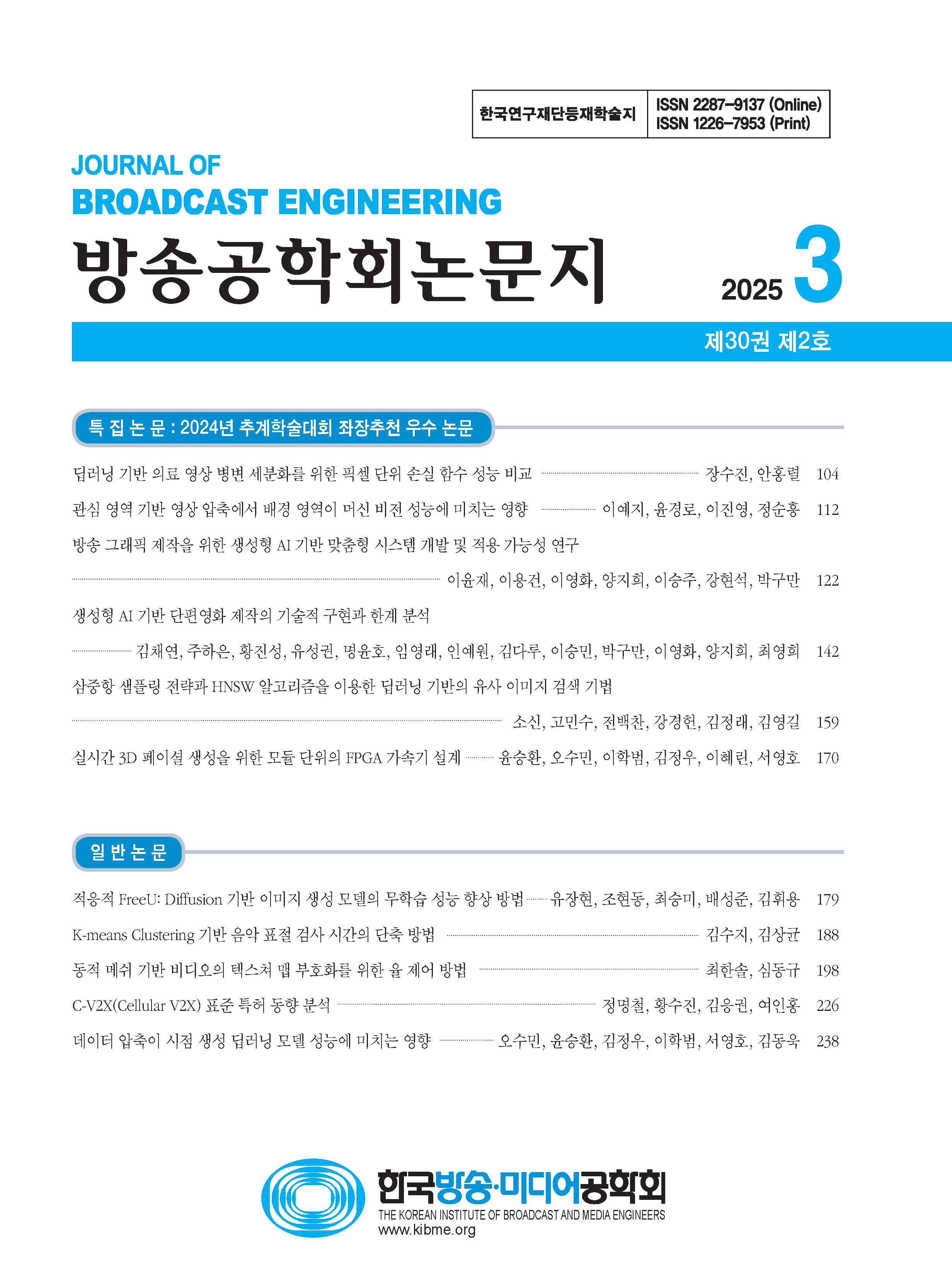| Browse Archives | About the Journal | Editorial Board | For Contributors | e-Submission |
- KCI(Korea Citation Index)
- DOI(CrossRef)
- DOI(CrossCheck)
Journal of Broadcast Engineering
ISSN : 1226-7953 (Print) / 2287-9137 (Online)
Sorry.
You are not permitted to access the full text of articles.
If you have any questions about permissions,
please contact the Society.
ņŻäņåĪĒĢ®ļŗłļŗż.
ĒÜīņøÉļŗśņØĆ ļģ╝ļ¼Ė ņØ┤ņÜ® ĻČīĒĢ£ņØ┤ ņŚåņŖĄļŗłļŗż.
ĻČīĒĢ£ Ļ┤ĆļĀ© ļ¼ĖņØśļŖö ĒĢÖĒÜīļĪ£ ļČĆĒāü ļō£ļ”Įļŗłļŗż.
About this Journal
History
JBE (Journal of Broadcast Engineering) was launched in March 1996 with biannual publication. It was selected as a candidate for accredited journal by National Research Foundation (NRF) of Korea in September 2004 and finally accredited by the foundation in January 2007. It has been published three time in a year since 2001 and four times since 2003. Since 2007 it has been published bimonthly, in January, March, May, September, November, and December. Currently about 100 technical papers are published by JBE.
Aims and Scope
The Journal of Broadcast Engineering (JBE), which is published by The Korean Institute of Broadcast and Media Engineers, is devoted to reports of original short communications, research and review articles. It includes regular papers, letters (short papers) and specially edited papers. The JBE encompasses all types of speech/audio and image/video signal processing for broadcasting technologies, broadcast contents management and application technologies, modulation/demodulation and transmission technologies for broadcasting, and broadcasting system technologies.
ISSN number and DOI prefix
ISSN : 2287-9137 (Online)
ISSN : 1226-7953 (Print)
DOI Prefix : http://dx.doi.org/10.5909/JBE
Financial Support
This work was supported by the Korean Federation of Science and Technology Societies grant funded by the Korea government.
Topics
| Category | Items in Detail |
|---|---|
| Speech/audio signal processing | Speech recognition/synthesis/coding/ conversion, natural language processing, audio encoding, music information processing, speech/audio quality improvement/ restore/quality evaluation, noise processing, sound recognition/synthesis/classification/separation, machine learning for voice/audio, virtual instruments, 3D sound, psychoacoustics, voice/audio modeling, hearing aid, bio signal processing |
| Video/image compression | Image/video coding technology, immersive video (360, 6DoF, etc.) coding, PCC (Point Cloud Coding), light field coding, depth image coding, 3D video coding, hologram coding, deep learning based image/video coding, pre-/post processing for video coding, SW/HW optimization, fast encoding/decoding algorithm, rate control, video transcoding, error-resilient video coding, image/video coding standard technology (HEVC, VVC, MPEG, JPEG, etc.) |
| Video/image processing | 3D computer vision, action and behavior recognition, biometrics, face/gesture/body pose, computational photography, image and video synthesis, datasets and evaluation, efficient training and inference methods for networks, low-level and physics-based vision, machine learning architectures, motion and tracking, neural generative models, auto-encoders, GANs, recognition (object detection, categorization), representation learning, deep learning, scene analysis and understanding, segmentation grouping and shape, video analysis and understanding, visual reasoning and logical representation |
| Broadcasting content production | Broadcasting program production technologies: content production technology, production workflow, camera technology, media & art convergence technology, digital video effects, broadcasting content editing and CG technology |
| Interdisciplinary research: storytelling for production of broadcast contents, media convergence technology, media technology-humanities convergence, digital humanity, philosophy of media technology, human sensibility ergonomics, cognitive science, other media-related convergence technology | |
| Broadcasting System | Broadcasting architecture including terrestrial, cable, satellite, IPTV platform, Internet-based streaming architecture, converged architecture between communication and broadcasting |
| Transmission System | Wireless broadcasting network: IEEE 802.22, wireless regional area network (WRAN) |
| modulation/demodulation, channel coding/decoding, antenna, MIMO/MISO, OFDM, equalization, synchronization, interference cancellation, software-defined radio, SFN | |
| Broadcasting Industry and Policy | Broadcasting equipment technologies: broadcasting on-demand, cable transfer splicing system, digital multimedia broadcasting, digital video broadcasting-multimedia home platform |
| Broadcasting application technologies: broadcasting communication network technology, data transmission & control, advanced common application platform, digital imaging and communication | |
| Policy for broadcasting-communication industry and promotion: promotion policy for the convergence service industry, cooperation and coordination between broadcasting-communication markets | |
| Policy for digital broadcasting and new media: policy for UHDTV/Hybrid TV/N-screen/Smart TV/MMS/convergence services, new media laws | |
| Broadcasting media policy: media convergence policy, new media technology policy, media marketing policy, new media service policy, media education policy, other media-related policy | |
| Media service | Realistic media service, broadcast media service, smart media service, one-person media service, OTT (Over-the-top) media service |
| Media intelligence | All areas of artificial intelligence technology and media: media recommendation, personalized broadcasting, user preference, media search, media analysis, semantic understanding, big data-based media selection and media processing, etc. |
| Realistic content | AR/VR, 360┬░VR, Hologram, MulSeMedia: VR, AR content creation, 360┬░ Content shooting technology, Hologram and similar hologram content production technology, MulSeMedia content |
| Media art: media art technology, creative technology, media entertainment technology, computer art, video art, holographic art, other CT related techno-art | |
| Media Interaction: media product or service-oriented interaction design(UI/UX), Interaction art, Game Interaction design, Interface/interaction design in the real/digital space design |














